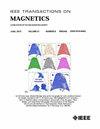各向异性生物流体晶体在磁场中的易平面排列:对棒取向的影响
IF 2.1
3区 工程技术
Q3 ENGINEERING, ELECTRICAL & ELECTRONIC
引用次数: 0
摘要
我们研究了具有与晶体c轴成斜角的易平面的棒状各向异性生物流体晶体在均匀磁场中的取向。对于足够强的磁场,这些晶棒会自我定位,使得晶体的平面与磁场平行,晶棒的方向被定义为晶体的c轴方向。当磁棒围绕晶体的硬轴旋转时,磁棒与磁场的夹角就会有一定范围。我们详细介绍了这种行为,首先提供插图的血色素晶体在不同的方向。这些插图清楚地表明,晶棒相对于磁场的取向角从大约30°到150°不等。我们还推导出了定向角的概率密度函数(pdf)的解析表达式。我们发现取向角在30°和150°范围内不是均匀分布的,而是倾向于聚集在这些极限附近。这提示了实验测试,并解决了在过去的文献中发现的关于杆方向的混淆。与其他各向异性生物流体晶体的相关性,如痛风产生的,也进行了讨论。本文章由计算机程序翻译,如有差异,请以英文原文为准。
Easy-Plane Alignment of Anisotropic Biofluid Crystals in a Magnetic Field: Implications for Rod Orientation
We study the orientation in a uniform magnetic field of rod-like anisotropic biofluid crystals with an easy plane that makes an oblique angle with the crystal’s c-axis. For a sufficiently strong field, these crystalline rods orient themselves, such that the crystal’s easy plane is parallel to the magnetic field, the rod’s direction being defined as the direction of the crystal’s c-axis. As the rod rotates about the crystal’s hard axis, there will, therefore, be a range of angles that the rod makes with the magnetic field. We detail this behavior by first providing the illustrations of hemozoin crystals at various orientations. These illustrations clearly demonstrate that the orientation angle that the crystalline rod makes with respect to the magnetic field varies from about 30° to 150°. We also derive an analytical expression for the probability density function (pdf) for the orientation angle. We find that the orientation angles are not uniformly distributed between the limits of 30° and 150°, but rather tend to cluster near these limits. This suggests experimental tests and addresses confusion about the rod orientation found in past literature. The relevance to other anisotropic biofluid crystals, such as those produced by gout, is also discussed.
求助全文
通过发布文献求助,成功后即可免费获取论文全文。
去求助
来源期刊

IEEE Transactions on Magnetics
工程技术-工程:电子与电气
CiteScore
4.00
自引率
14.30%
发文量
565
审稿时长
4.1 months
期刊介绍:
Science and technology related to the basic physics and engineering of magnetism, magnetic materials, applied magnetics, magnetic devices, and magnetic data storage. The IEEE Transactions on Magnetics publishes scholarly articles of archival value as well as tutorial expositions and critical reviews of classical subjects and topics of current interest.
 求助内容:
求助内容: 应助结果提醒方式:
应助结果提醒方式:


